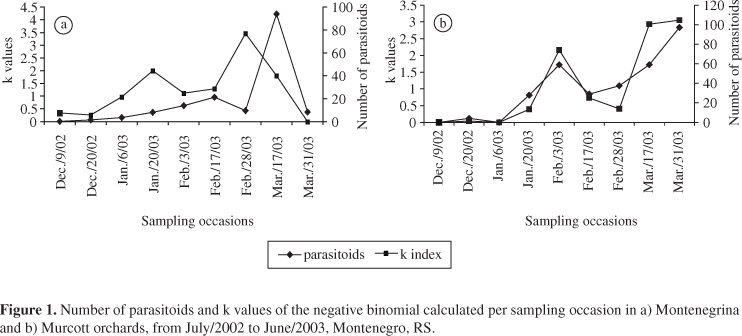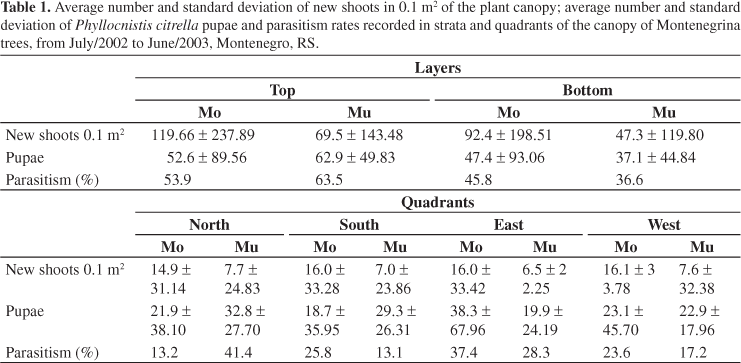Many species of microhymenopterous parasitoids have been registered on Phyllocnistis citrella, the citrus leafminer. The present study aimed to identify the spatial distribution pattern of the native and introduced parasitoids of P. citrella in two citrus orchards in Montenegro, RS. The new shoots from 24 randomly selected trees in each orchard were inspected at the bottom (0-1.5 m) and top (1.5-2.5 m) stratum and had their position relative to the quadrants (North, South, East and West) registered at every 15 days from July/2002 to June/2003. The leaves with pupae were collected and kept isolated until the emergence of parasitoids or of the leaf miner; so, the sampling was biased towards parasitoids that emerge in the host pupal phase. The horizontal spatial distribution was evaluated testing the fitness of data to the Poisson and negative binomial distributions. In Montenegrina, there was no significant difference in the number of parasitoids and in the mean number of pupae found in the top and bottom strata (χ2 = 0.66; df = 1; P > 0.05) (χ2 = 0.27; df =1; P > 0.05), respectively. In relation to the quadrants, the highest average numbers of the leafminer pupae and of parasitoids were registered at the East quadrant (χ2 = 11.81; df = 3; P < 0.05), (χ2 = 10.36; df = 3; P < 0.05). In the Murcott orchard, a higher number of parasitoids was found at the top stratum (63.5%) (χ2 = 7.24; df =1 P < 0.05), the same occurring with the average number of P. citrella pupae (62.9%) (χ2 = 6.66; df = 1; P < 0.05). The highest number of parasitoids and of miners was registered at the North quadrant (χ2 = 19. 29; df = 3; P < 0.05), (χ2 = 4.39; df = 3; P < 0.05). In both orchards, there was no difference between the numbers of shoots either relative to the strata as well as to the quadrants. As the number of shoots did not varied much relative to the quadrants, it is possible that the higher number of miners and parasitoids in the East and West quadrants would be influenced by the higher solar exposure of these quadrants. The data of the horizontal spatial distribution of the parasitism fit to the negative binomial distribution in all sampling occasions, indicating an aggregated pattern.
citrus leafminer; biological control; parasitoids; Hymenoptera



